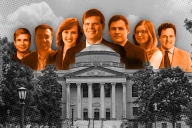You have /5 articles left.
Sign up for a free account or log in.
The current public assumption that safe spaces and trigger warnings conflict with academic freedom and are the result of political correctness gone mad is a false dichotomy. If students today are indeed more fragile, then it is vital that we in higher education understand: (1) the specific nature of this sensitivity and (2) what colleges can do to help.
After this divisive election, we will need more capacity for talking about controversial issues. While the anonymity of social media may have escalated invective, it has not made for more ease with difficult conversations. Technology has allowed a generation to end relationships by text message, or even by “ghosting” an ex -- deleting a relationship from your life without any conflict or effort.
Avoiding conflict, of course, also sacrifices an opportunity to learn. Our campuses and world, meanwhile, are increasingly more religiously, culturally and ethnically diverse and now more politically divided. So at the very moment when we have more varied ideas, thoughts and opinions on our campuses, we also have students who are less equipped and perhaps less eager to have challenging discussions.
The U.S. Department of Education recently issued a Dear Colleague letter to college presidents asking that we help students learn to disagree in a “respectful manner.” But what it means to be “disrespected” is highly contested, so we are indeed having difficult conversations about trigger warnings and safe spaces. Ultimately, college is about helping students think critically. That requires learning how to interrogate complexity while withholding judgment and trying to feel safe in precisely those uncomfortable spaces where our ideas and attitudes are being challenged.
But this is a process. The first stage of college is finding a safe home. We learn much more when we explore from a place of safety, have the rights tools and feel accepted as equal partners in the discourse. The news media has greatly exaggerated the very few students who want “protection” from ideas they find uncomfortable. Safe spaces are mostly simply places of congregation, and assembly with other people who share your ideas, history and culture is a basic human impulse. With a safe home base established, we can then encourage students to venture into discussions in which they may have greater discomfort.
Pedagogy is about moving from comfort to discomfort and eventually finding comfort in discomfort. The measure of a college, then, has nothing to do with the sensitivity of its first-year students or if their professors use trigger warnings, but rather with the outcomes. Can we teach students to embrace ambiguity and discomfort? And, if so, how?
A Path Forward
First, colleges must assemble a diverse community of learners. Employers say they want graduates who can solve complex problems with people who are not like them. This year, for example, the first-year class at Goucher College is 35 percent students of color and 25 percent Pell-eligible students. We also have students from 60 countries on our campus, and we require 100 percent of our undergraduates to study abroad, as travel can be a great way to encounter differences and discover that not everyone speaks or thinks as you do.
But bringing diverse students together is just the beginning. To have open, meaningful and difficult conversations, young people also need to learn to live with a higher tolerance for ambiguity -- or “the tendency to perceive ambiguous situations as desirable.” It is essential for democracy, and it is being used in research on global leadership because it is related to cross-cultural communication and performance in diverse work environments. At Goucher College, we use a Tolerance for Ambiguity scale that asks students to respond to statements like:
- An expert who doesn’t come up with a definite answer probably doesn’t know too much.
- A good teacher is one who makes you wonder about your way of looking at things.
- The sooner we all acquire similar values and ideals the better.
We are using that tool and other existing psychological constructs to measure where our students are when they first arrive on our campus in terms of dealing with ambiguity, and then we follow up every year to see if and when they have progressed. All of this is confidential and analyzed by researchers only in the aggregate. We will, however, look for patterns and connect trends with pedagogy and activities. (Are juniors willing to take more cognitive risk? Did our required study abroad experience increase cultural sensitivity?)
This work is at an early stage, but our hope is that we will come to understand better how college and various interventions can have an impact. We have begun by actively doing everything we can as college administrators and faculty members to demonstrate that there are multiple good answers, that knowledge is complex and that we can change our minds.
We must also be intellectual and ethical role models, so on our campus, we are responsive and transparent about student concerns. We routinely engage students in open meetings and alter policy as a result of their input. It is certainly more work, but it has the dual benefit of building community while modeling that smart people have open minds.
We must also create a campus culture that invites and supports the most difficult conversations. On a night of unrest in Baltimore, I joined a spontaneous gathering of dozens of faculty members and students watching the news. Late into the night, students continued to share their responses, fears, anxieties, hurts and pains. It was profoundly uncomfortable -- and we all learned. In the weeks that followed, we decided we need to be even more uncomfortable, and a group of faculty members created a seven-week seminar, Back to School on Race. More than 150 faculty and staff members signed up and participated -- and we all learned more about the deep structures of racial inequity as seen through the lenses of multiple disciplines, as well as the ongoing pain and discomfort that such topics bring to many members of our own community. This became a springboard to further conversations about curriculum, pedagogy, support and campus culture.
Thus, to help our students embrace discomfort, we must first establish a home for them. Later we encourage them to encounter discomfort, allow them the time to reintegrate that new information and then send them back out to embrace more discomfort.
Next fall, we will also introduce a new curriculum that begins with a first-year seminar designed to welcome students to the world of inquiry through faculty members who model their own passionate exploration of a topic of their choosing, with the focus more on how faculty are thinking about their topic rather than what they are thinking. Students will then take three exploration courses that are based in our new interdisciplinary academic centers. Over four years, and not in a single course, students will also need to demonstrate that they are racially and culturally literate.
We encapsulate all these efforts in our new version of the three R’s of learning: relationships, resilience and reflection. We start by getting to know our students. We emphasize to them the importance of building relationships that will prepare them for more discomfort. We focus on resilience (and also measure this in our students) because we have found that, in general, those who see failure as an opportunity learn more, grow personally and succeed professionally. Conflict and failure allow us to test boundaries and open us up to new ideas and new perspectives.
Reflection is what ties it all together and feeds our compassion and social conscience, so we will soon require all graduating students to develop a reflection portfolio. Recognizing there are a multiplicity of accents, experiences, histories and values living all around us is a first step, but we must then also reconsider our own values, frameworks and prejudices, and then confront our differences honestly.
Technology and globalization have increased our exposure to difference, but that alone has not opened hearts and minds. The internet offers us increasing access to new ideas and knowledge, and most of what students will need to know for the jobs of the future, they will need to learn as they go along after they graduate. That means that colleges should focus less on making sure we cover the content and more on teaching students how to become self-regulated learners. New knowledge is only really useful if you know how to let it in and allow it to change your mind. We need to rethink the pedagogical processes by which we get students to truly embrace difference.
Without critical thinking, discernment and reflection, democracy retreats from the sound of the loudest voice. The value of the liberal arts will only increase as knowledge and ideas proliferate. We need graduates who are not only capable of difficult conversations but also eager to listen and reflect. Perhaps we should restrict degrees to those who realize the answer to most difficult questions is almost always “It depends.”








